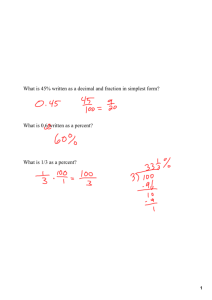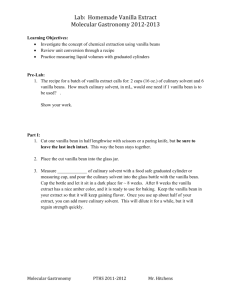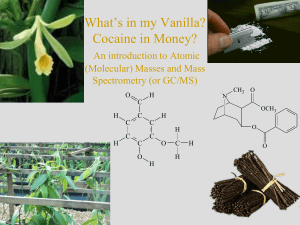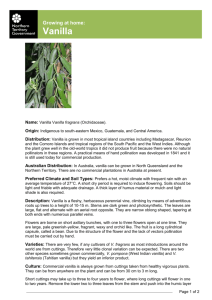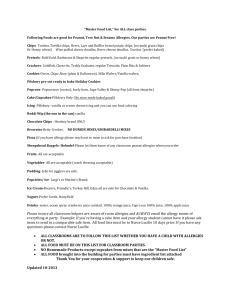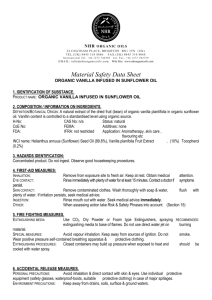! "#$%&'()!#*+$,#'*+! "-.!/011.234!56!2-.!781.!"95:3;81!#.<509;.<!&4<23202.!
advertisement
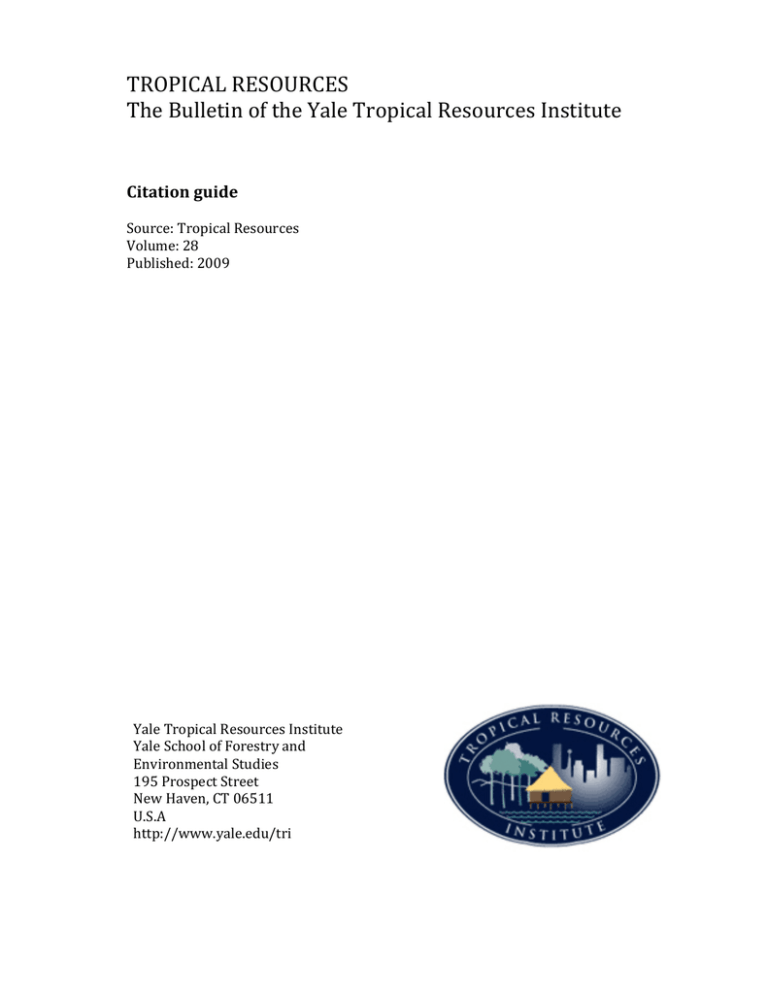
! ! "#$%&'()!#*+$,#'*+! "-.!/011.234!56!2-.!781.!"95:3;81!#.<509;.<!&4<23202.! ! ! ! ! "#$%$#&'!()#*+! ! +509;.L!"95:3;81!#.<509;.<! N510A.L!OP! %0Q13<-.?L!OIIC! ! ! ! ! ! ! ! ! ! 781.!"95:3;81!#.<509;.<!&4<23202.! 781.!+;-551!56!=59.<29>!84?!! *4@3954A.4281!+20?3.<! BCD!%95<:.;2!+29..2! E.F!G8@.4H!'"!IJDBB! ,K+K(! -22:LMMFFFK>81.K.?0M293!! ! ! ! ! ! ! ! ! Writing Knowledge: Re-articulations of Vanilla Production in Imorona, Madagascar Sarah Osterhoudt, PhD candidate Introduction When I arrived in the village of Imorona on the northeastern coast of Madagascar this last summer, several local vanilla farmers immediately started talking to me about a new project. They had decided to write and publish a small booklet about cultivating and curing vanilla beans, emphasizing organic [LJOUPX\LZ;OLIVVRSL[^V\SKILTHKLH]HPSHISL[V local farmers. I was already friends with many of the farmers who were organizing the book project, having previously lived with my husband in the town as Peace Corps volunteers. Returning to the rural village for pre–dissertation research, I was pleased to hear about the idea to produce a book about vanilla, as it continued the project I had worked on previously — to establish more direct linkages between rural vanilla bean farmers and U.S. markets, in part through assisting farmer groups to obtain organic JLY[PÄJH[PVU delicate cultivation and curing process. Knowledge about vanilla is passed down through apprenticeship models, either formal or informal. Much of this shared knowledge is nonverbal — when showing me OV^[VOHUK¶WVSSPUH[LH]HUPSSHÅV^LYMVYL_HTWSL people demonstrated the process using very few ^VYKZ-PN\YLZHUK Throughout the cultivation and curing cycle there are many interactions between the senses and knowledge production. Successful farmers learn sensitive, tactile maneuvers at each stage of production. 0UOHUK¶WVSSPUH[PVUKLSPJH[LÅV^LYWHY[ZHYLWYLZZLK together with exactly the right degree of pressure. =HUPSSHILHUZHYLZX\LLaLK[VKL[LYTPUL[OLPYYPWLness. Before blanching the green vanilla beans, farmers dip their hands into the hot water to gauge its temperature. Cured black beans are stretched and shaped and tied into bundles. Bundles are smelled Families in the village of Imorona, which has about 2500 residents, have been cultivating vanilla for approximately one hundred years. Most vanilla cultivators own their own small plots of land, and plant vanilla vines as a part of diverse and complex agroforestry systems which include rice, clove trees, fruit trees, coffee plants, cassava, sweet potatoes, and palm trees. The clove and vanilla harvests provide families with most of their cash income for the year. Over the past seven years, however, international vanilla bean prices have dropped by over ninety perJLU[;OPZKYVWPU[OL]HUPSSHILHUWYPJLZOHZZPNUPÄJHU[S`HMMLJ[LK[OLHIPSP[`VMMHYTLYZ[VHKLX\H[LS` provide for the basic needs of their families. Acting Knowledge (ZHUVYJOPK]HUPSSHYLX\PYLZJVUZ[HU[H[[LUtion and care and is considered along with saffron to be the most labor–intensive crop in the world. Working closely with vanilla producers in Imorona for two years, I began to notice certain characteristics of the knowledge and specialized skills involved in the Figure 1. A family out in their field hand–pollinating vanilla flowers. Tropical Resources Bulletin 13 Sarah Osterhoudt Figure 2. A young girl practicing the hand–pollination of vanilla flowers. and sorted by the strength of their fragrance. All told, each vanilla bean is probably touched hundreds of times before it leaves Imorona for other markets. In producing vanilla, therefore, farmers must exercise their senses as a skill. Their ability to accurately monitor the information conveyed by the ZLUZLZOHZPTWVY[HU[JVUZLX\LUJLZVU[OLX\HSP[` VMVUL»Z]HUPSSHOHY]LZ[;OLZLZRPSSZHYLSLHYULKV]LY time through practice, experience, and mentoring. Vanilla production thus represents what Taussig JHSSZ[OL¸[HJ[PSP[`VMRUV^SLKNL¹^OLYLI` people know things through touching and experiencing them. The senses are thus for vanilla farmers “the switching place where the structure of experience and the structure of knowledge converge and cross” :LYLTL[HRPZ 6]LY[PTLZ\JO\ZLZVM[OL senses become increasingly automated and habituated. The knowledge of vanilla production also repYLZLU[ZHMVYTVM¸TL[PZ¹RUV^SLKNL:JV[[ This type of knowledge includes practical skills, and is often referred to as know–how, common sense, VYHZOH]PUNHRUHJRMVYZVTL[OPUN0[PZ¸HJX\PYLK intelligence” that is plastic, adaptive and “excep[PVUHSS`KPMÄJ\S[[V[LHJOHWHY[MYVTILPUNLUNHNLK PU[OLHJ[P]P[`P[ZLSM¹:JV[[ 0[PZHSZVTVZ[S` passed down through oral forms, as opposed to written forms. 14 Volume 28, Spring 2009 Writing Knowledge / Power When I returned to Imorona last summer, I was therefore somewhat surprised to hear that the farmers were planning to write about their knowledge of vanilla farming. Farmers explained to me that they decided to embark on the project to teach other farmers, especially younger farmers, about the JVTWSPJH[LKWYVJLZZVMVI[HPUPUNVYNHUPJJLY[PÄJHtion. The previous year, when we had all worked [VNL[OLY[VVI[HPUJLY[PÄJH[PVU^LZVVUYLHSPaLK[OH[ the inspection process involved a large amount of paperwork. Recognizing that the process of organic JLY[PÄJH[PVUSHYNLS`KLWLUKLKVU^YP[PUN[OLMHYTers responded by producing their own written document. The decision to produce a written document contrasts with the uneasiness that Imorona farmers often exhibit towards writing. Many individuals struggle with literacy and have come to associate writing and documents with cumbersome government bureaucracy. Who has the power to write things down and [VJYLH[L[OLVMÄJPHS^YP[[LUYLJVYKVM[LUJVPUJPKLZ with who exercises the most political and economic WV^LYPUHZVJPL[`:RHYPH 0U[OLWYVJLZZVM VYNHUPJJLY[PÄJH[PVUMVYL_HTWSL[OLPUZWLJ[VY^HZ the only person who wrote down information about [OLMHYTLYZHUK[OLPYÄLSKZ"[OLMHYTLYZ[OLTZLS]LZ VUS`HUZ^LYLKX\LZ[PVUZ;O\ZI`WYVHJ[P]LS`WYVducing a written booklet about vanilla, and by plan Re-articulations of Vanilla Production in Madagascar ning to make the document available to all Imorona residents, the vanilla producers could be seen to be IHSHUJPUNV\[[OLPULX\P[PLZVMYLWYLZLU[H[PVU;OL` showed that they too wrote things down and codiÄLKRUV^SLKNL temperature the water should be. He told them, and this temperature was added into the description, thus JYLH[PUNHISLUKVMTL[PZHUKX\HU[PÄLK¸ZJPLU[PÄJ¹ knowledge. The farmers also learned from the NGO representative that vanilla was a vahiny, or non–native, plant. She explained that vanilla was originally from Translations Mexico, and was brought to Madagascar by the -YLUJOHYV\UK0U[OLKYHM[VM[OLWHTWOSL[ A team of thirteen men and women was the section on the history of vanilla left out the role assembled to oversee the writing of the booklet. of the French entirely — saying only that vanilla The team included older farmers from several local farmer associations, a representative of a local NGO, was a “child” of Mexico that “brought itself” to Madagascar. The removal of French traces from the the two new Imorona Peace Corps volunteers, the local “wordsmith” who was known for his adeptness vanilla narrative was also illustrated in the attention H[ZWLLJOTHRPUN[OLWYLZPKLU[VM[OLSVJHS^VTLU»Z that the participants paid to the exact wording of the pamphlet. The group decided to use only Malaassociation, and a local agricultural technician who gasy words taken from their local dialect. In their OHKOLSWLK[OLMHYTLYZ^P[O[OLPYVYNHUPJJLY[PÄJHdiscussion, it soon became apparent that many of [PVU[OLWYL]PV\Z`LHY-PN\YL the words used for vanilla cultivation were actually French derivatives and not “real” Malagasy words. Overall, the book was an exercise in translatThe participants debated over what Malagasy word ing the metis knowledge of vanilla production into to use for French terms such as “supple” “orchid” written form — something that is extremely tricky and even “shelf.” Especially interesting was the disto do. This process of translation sparked a lot of in– depth discussions, as farmers compared their cultiva- cussion on how to translate the concept of “organic” [PVU[LJOUPX\LZ^P[OVULHUV[OLYHUKKLIH[LK^OPJO itself, commonly referred to as bio from the French ]LYZPVU^HZ¸ILZ[¹;O\Z[OLWS\YHSP[`VM[LJOUPX\LZ biologique. After much discussion, the participants TVYWOLKPU[VVUL¸VMÄJPHS¹]LYZPVU;OLRUV^SLKNL agreed to use the phrase voly–zanahary which means “crops from God.” The deliberate decision to YLJVYKLKMVY[OLWHTWOSL[HSZVPUJS\KLKX\HU[P[Hremove all traces of the French echoed the observative descriptions and measurements. For example, [PVUZVM[OLHU[OYVWVSVNPZ[4H\YPJL)SVJO when writing about blanching the vanilla beans, the that, for the Malagasy, speaking in French is often farmers did not only write that one should test the associated with the experiences of colonial water by hand, but also asked the technician what Figure 3. Participants at the booklet–writing workshop. Tropical Resources Bulletin 15 Sarah Osterhoudt subordination. Bloch also noted that the language of administration is often conducted in French, and this PZJLY[HPUS`[Y\LVMVYNHUPJJLY[PÄJH[PVUWHWLY^VYR By writing their own documents in the local language, rural farmers were claiming some power over how their knowledge was catalogued. Projects aimed at making a population more ¸TVKLYU¹VM[LUHJ[HZOVTVNLUPaPUNPUÅ\LUJLZ and this can partly be seen with this booklet project :JV[[ 2UV^SLKNL^HZX\HU[PÄLKHUK[HRLU out of its larger social and environmental contexts. 6UL¸VMÄJPHS¹]LYZPVUVMOV^[VJ\S[P]H[L]HUPSSH was decided upon. Vanilla was no longer a multi– MHJL[LKZVJPHSS`ZPNUPÄJHU[LU[P[`I\[HJVSSLJ[PVUVM ZWLJPÄJMVJ\ZLK[LJOUPX\LZ(S[OV\NOT\JOVM[OL “metis” details are lost in translation, I argue that the vanilla booklet does not signify an overall “loss” of metis knowledge itself. Rather, the process of writing the booklet represented a deepening of metis. Sitting in the room together, the participants learned a new type of “practical” knowledge: how to write a pamphlet. They were experimenting with ways to respond to the changing situations of the global ]HUPSSHTHYRL[0U[OPZ^H`[OLIVVRSL[L_LTWSPÄLK the shifting, adaptive, multi–layered nature of metis in action. The pamphlet project also illustrates how experimenting with new forms of knowledge can be both globalizing and localizing. In responding to [OL¸NSVIHS¹KPZJV\YZLVMVYNHUPJJLY[PÄJH[PVU[OL booklet deliberately framed its discussion as local to Imorona. It did not try to erase the localness of the NYV^LYZ»RUV^SLKNL·PUJVU[YHZ[[OLIVVRSL[VM[LU made particular references to Imorona. The committee wanted to include photos from Imorona in the booklet, not generic illustrations. The project goal was thus not to erase “Imorona–ness” to make their vanilla global, but to emphasize the “on–siteness” of vanilla production. It was not a “shadow” of global discourse — a metaphor often used to describe African engagement with global entities (Ferguson, 9H[OLYP[^HZ]LY`T\JOP[ZV^UHJ[P]L deliberate production. Conclusion Overall, the strategic layers of action represented by this pamphlet suggest that rural farmers in Imorona are exhibiting proactive agency in a globalizing world. This agency is seen through the lens of vanilla production. Such power is often denied to 16 Volume 28, Spring 2009 rural Africans, who are instead described as being “swept up” in globalization in a way that they lose their sense of place, or as “being left behind” by globalization in a way that keeps them static. The vanilla book project, in contrast, can be seen as an attempt for rural farmers to put themselves literally at the center of global discourse. In writing about organic vanilla production, then, the thirteen individuals were experimenting both with knowing things and with ways of knowing things. Overall, we can hope that all this attention to knowledge will have some practical metis effect — namely, that the next round of the organic inspection will proceed ZTVV[OS`^OPJO^PSSZ\IZLX\LU[S`NP]LMHTPSPLZ TVYL]PHISLVW[PVUZ[VÄUKTHYRL[ZMVY[OLPYJYVWZ Acknowledgements I would like to thank the Tropical Resources Institute, the MacMillan Center, the Agrarian Studies Program, and the Lindsay Fellowship for their generous support of this summer research. I also am thankful to my dissertation advisers, Dr. Dove and Dr. Sivaramakrishnan, for their guidance and insights. I would especially like to acknowledge the community of Imorona, and the farmer associations FIMPAMA and HITA, for welcoming me into their community and for sharing with me their knowledge of vanilla, and of the world. References )SVJO4 How we think they think: Anthropological approaches to cognition, memory and literacy. Westview Press, Colorado. -LYN\ZVU1HTLZGlobal Shadows: Africa in the NeoLiberal World Order. Duke University Press, Durham. :JV[[1* Seeing like a state: How certain schemes to improve the human condition have failed. Yale University Press, New Haven. :LYLTL[HRPZ*5 *VU[L_[Z7W]PP¶_P"¶PU! C.N. Seremetakis, editor. The senses still: perception and memory as material culture in modernity. The University of Chicago Press, Chicago. :RHYPH( >YP[PUNVYHSP[`HUKWV^LYPU[OL+HUNZ 7W¶PU!:(TPUHUK+*OHRYHIHY[`LKP[VYZ Subaltern studies IX: writings on South Asian history and society. Oxford University Press, New Delhi. ;H\ZZPN4 York. The Nervous System. Routledge, New
